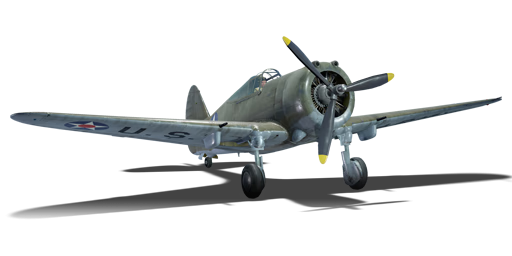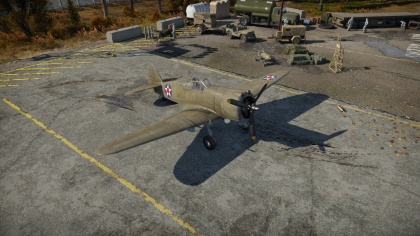P-36C
Contents
| This page is about the American fighter P-36C. For other uses, see P-36 (Family). |
Description
The P-36C Hawk is a rank I American fighter
with a battle rating of 2.0 (AB), 1.7 (RB), and 2.3 (SB). It was introduced in Update 1.31.
General info
Flight Performance
Describe how the aircraft behaves in the air. Speed, manoeuvrability, acceleration and allowable loads - these are the most important characteristics of the vehicle.
Stat card
| Characteristics | |||||||
|---|---|---|---|---|---|---|---|
| Stock | |||||||
| Max Speed (km/h at 3,048 m) |
Max altitude (meters) |
Turn time (seconds) |
Rate of climb (meters/second) |
Take-off run (meters) | |||
| AB | RB | AB | RB | AB | RB | ||
| 473 | 462 | 9,754 | 17.2 | 18.2 | 4.4 | 6.9 | 183 |
| Upgraded | |||||||
| Max Speed (km/h at 3,048 m) |
Max altitude (meters) | Turn time (seconds) | Rate of climb (meters/second) |
Take-off run (meters) | |||
| AB | RB | AB | RB | AB | RB | ||
| 531 | 501 | 9,754 | 16.8 | 17.0 | 19.4 | 10.6 | 183 |
Details
| Features | ||||
|---|---|---|---|---|
| Combat flap | Take-off flap | Landing flap | Air brakes | Arrestor gear |
| ✓ | ✓ | ✓ | X | X |
| Limits | ||||
|---|---|---|---|---|
| Wing-break speed (km/h) |
Gear limit (km/h) |
Combat flap (km/h) |
Max Static G | |
| + | - | |||
| 670 | 290 | 520 | ~17 | ~9 |
| Optimal velocities | |||
|---|---|---|---|
| Ailerons (km/h) |
Rudder (km/h) |
Elevators (km/h) |
Radiator (km/h) |
| < 290 | < 380 | < 460 | > 250 |
| Compressor (RB/SB) | ||
|---|---|---|
| Setting 1 | ||
| Optimal altitude | 100% Engine power | WEP Engine power |
| 1,981 m | 1,050 hp | 1,299 hp |
Engine performance
| Engine | |||||
|---|---|---|---|---|---|
| Engine Name | Number present | ||||
| Pratt & Whitney R-1830-17 14-cylinder | 1 | ||||
| Engine characteristics | |||||
| Weight (each) | Type | Cooling | |||
| 675 kg | Radial | Air | |||
| Engine power (Stock) | |||||
| Mode | Max | Take-off | |||
| Arcade | 918 hp | 1,165 hp | |||
| Realistic/Simulator | 1,092 hp | 1,340 hp | |||
| Engine power (Upgraded) | |||||
| Mode | Max | Take-off | |||
| Arcade | 907 hp | 1,025 hp | |||
| Realistic/Simulator | 1,081 hp | 1,1 h99p | |||
| WEP Duration | |||
|---|---|---|---|
| Arcade | Realistic/Simulator | ||
| 25 seconds | Infinite | ||
Survivability and armour
- 9.5 mm armoured pilot seat
- Self-sealing fuel tanks
Armaments
Offensive armament
The P-36C is armed with:
- 1 x 12.7 mm Browning M2 machine guns, nose-mounted (200 rpg)
- 1 x 7.62 mm Browning M1919 machine gun, nose-mounted (500 rpg)
- 2 x 7.62 mm Browning M1919 machine guns, wing-mounted (500 rpg = 1,000 total)
Usage in battles
This aircraft is an all-round performer, with later versions taking on FW-190s and later 109 F variants. It has an excellent turn time at low and high speeds, a good dive speed and good rate of climb. Its higher altitude performance is fairly average, but this doesn't really matter since most lower tier games occur at lower/ ground level. The issue with the C variant is that its armament is sometimes in-effective against higher tier aircraft with armour, as well as the ammo count, being quite small, meaning frequent reloads. In Realistic Battles, it is recommended to climb straight- side-climbing can be done, but isn't normally necessary- and gain altitude over your opponent, before diving and pulling numerous energy loops, oval-shaped flight moves over the enemy. Head-ons, especially with little armour and the large radial engine, is not recommended unless the enemy is known to be weaker. A P-36 has the speed to catch and escort bombers if they choose to wait, and can do an excellent job of escorting higher tier bombers. The one weakness of the plane's manoeuvrability is its role rate, which can be countered by hard yaw movements, although this is only advised in large direction changes. In dog-fights, this reduces speed and accuracy.
Manual Engine Control
| MEC elements | ||||||
|---|---|---|---|---|---|---|
| Mixer | Pitch | Radiator | Supercharger | Turbocharger | ||
| Oil | Water | Type | ||||
| Not controllable | Controllable No automatic pitch |
Controllable | Not controllable | Combined | Not controllable | Not controllable |
Pros and cons
Pros:
- Excellent climb speed.
- Excellent dive speed.
- Better-than-average turn-radius.
- Good energy retention.
Cons:
- Small ammo count.
- Sometimes in-effective weapons.
- No bombs.
- Less-than-average roll rate at certain speeds.
- Weak armour.
- Poor in a head-on.
- Large engine that can get hit.
History
Describe the history of the creation and combat usage of the aircraft in more detail than in the introduction. If the historical reference turns out to be too big, take it to a separate article, taking a link to the article about the vehicle and adding a block "/ History" (example: https://wiki.warthunder.com/(Vehicle-name)/History) and add a link to it here using the main template. Be sure to reference text and sources by using <ref>, as well as adding them at the end of the article. This section may also include the vehicle's devblog entry (if applicable) and the ingame encyclopedia description (under === Encyclopedia Info ===, also if applicable).
In-game description
"The P-36A's “teething problems” were so serious that its introduction was halted in several squadrons and flights with the new fighters were limited. Many of the planes were left grounded and waiting for the modernization they needed.
The Curtiss company had to fix the situation quickly. The measures they took resulted in the creation of the new P-36C model with a strengthened airframe and improved exhaust system.
They also made modifications to the powerplant – the new model was powered by the air-cooled Pratt & Whitney R-1830-17 Twin Wasp engine with a maximum output of 1,200 hp.
The P-36A's firepower was inferior to that of European fighters of the time, such as the Spitfire and Bf.109D, so its armament was enhanced. Two more 7.62 mm Colt-Browning ANM2.3 machine guns with 500 rounds each were mounted on the wing panels, supplementing the two synchronized machine guns the plane already possessed.
These Brownings were equipped with special containers mounted under the wing for the collection of spent shell casings. This was done to prevent changes to the plane's center of gravity as its ammunition was used.
In spite of its increased flight weight of 2,630 kg, the new engine increased the plane's maximum speed, which reached the round number of 500 km/h at a height of 3,000 m.
A total of 30 P-36C planes were produced.
By the time Japan attacked the USA, most P-36 planes still in service were being used as training vehicles. However, they were still present in fighter squadrons in distant regions such as Alaska, the Panama Canal Zone and Hawaii. It was these planes that had to go into battle against the attacking enemy.
When Japan attacked Pearl Harbor on 7 December 1941, there were 45 P-36As in Hawaii, 44 of which were part of the three squadrons and command division of the 15th PG. Ten of the Hawks were destroyed or damaged in attacks on airfields. After the first wave from the Japanese, four standby P-36s from the 46th Pursuit Squadron were able to take off and chase the retreating group of 11 B5N2 torpedo bombers and A6M fighters.
In the resulting battle, they shot down two Japanese planes, making these the first USAAC conquests in the Pacific War. On the same day, P-36s made another 14 combat flights in search of Japanese aircraft carriers.
The American Hawks ended their combat operations there. P-36 planes were quickly removed from active service and given to training subdivisions, which used them until mid-1943."
Media
Skins and camouflages for the P-36C from live.warthunder
See also
Links to the articles on the War Thunder Wiki that you think will be useful for the reader, for example:
- reference to the series of the aircraft;
- links to approximate analogues of other nations and research trees.
External links
Paste links to sources and external resources, such as:
- topic on the official game forum;
- encyclopedia page on the aircraft;
- other literature.
| USA fighters | |
|---|---|
| P-26 Peashooter | P-26A-33 · P-26A-34 · P-26A-34 M2 · P-26B-35 |
| P-36 Hawk | P-36A · Rasmussen's P-36A · P-36C · ○P-36C · P-36G |
| P-39 Airacobra | P-400 · P-39N-0 · P-39Q-5 |
| P-40 | P-40C · P-40E-1 · P-40E-1 TD · P-40F-10 |
| P-43 Lancer | P-43A-1 |
| P-47 Thunderbolt | P-47D-22-RE · P-47D-25 · P-47D-28 · P-47M-1-RE · ⋠P-47M-1-RE · P-47N-15 |
| P-51 Mustang | P-51 · P-51A (Thunder League) · P-51C-10 · P-51D-5 · P-51D-10 · P-51D-20-NA · P-51D-30 · P-51H-5-NA |
| P-63 Kingcobra | P-63A-5 · P-63A-10 · P-63C-5 · ␠Kingcobra |
| Prototypes | XP-55 |
| F2A Buffalo | F2A-1 · Thach's F2A-1 · F2A-3 |
| BF2C | BF2C-1 |
| F3F | F3F-2 · Galer's F3F-2 |
| F4F Wildcat | F4F-3 · F4F-4 |
| F4U Corsair | F4U-1A · F4U-1A (USMC) · F4U-1D · F4U-1C · F4U-4 · F4U-4B · F4U-4B VMF-214 · F2G-1 |
| F6F Hellcat | F6F-5 · F6F-5N |
| F8F Bearcat | F8F-1 · F8F-1B |
| Other countries | ▃Ki-43-II · ▃Ki-61-Ib · ▃A6M2 · ▃Bf 109 F-4 · ▃Fw 190 A-8 · ▃Spitfire LF Mk IXc |





